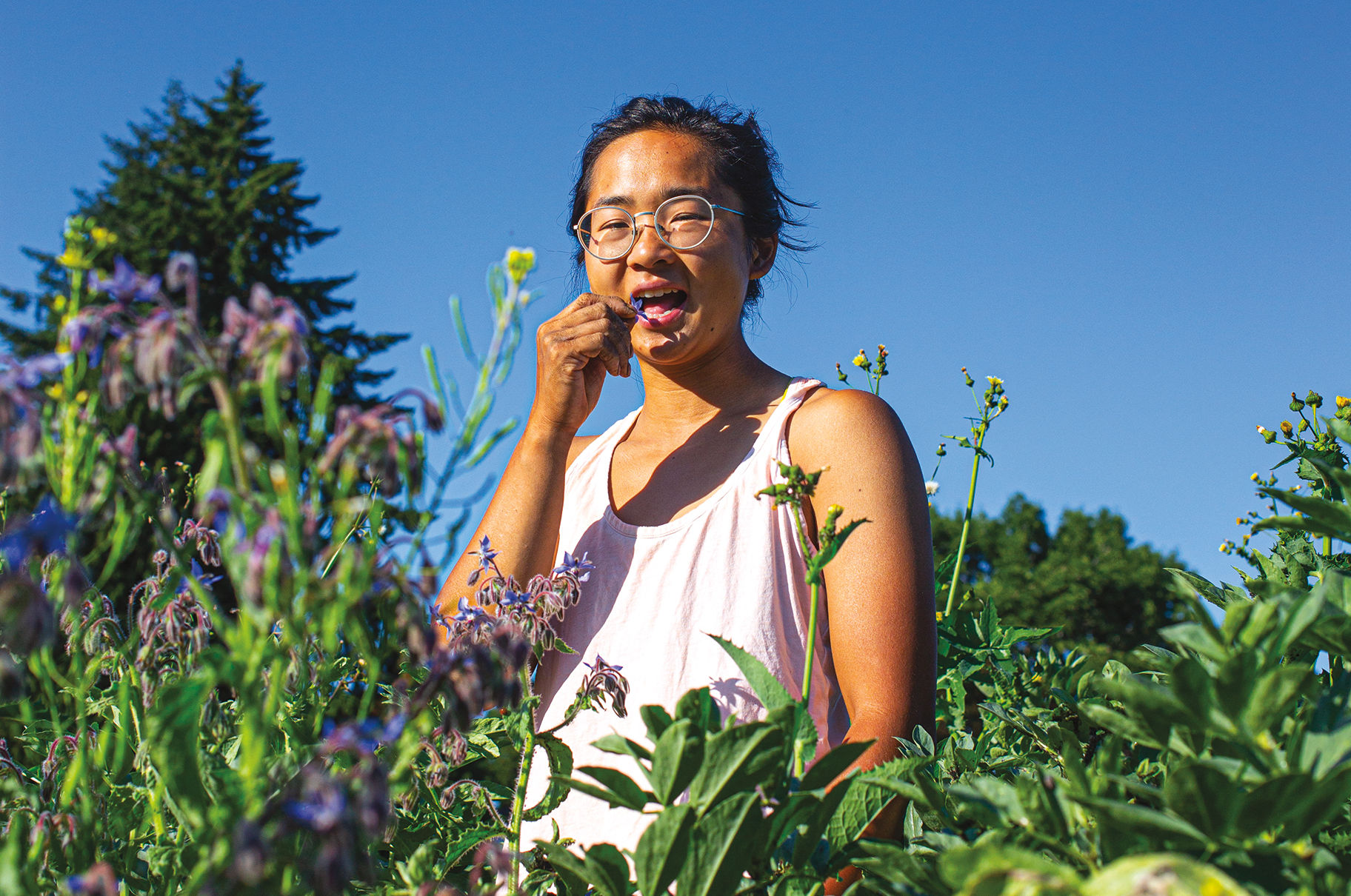
Asian Veggies Grow at Mora Mora Farm in Gresham
When Catherine Nguyen started Mora Mora Farm in 2018, she grew many of the same things farmers in Oregon grow every year: kale, carrots, tomatoes.
But with growing anti-Asian sentiment due to the pandemic, Nguyen, a 28-year-old Vietnamese American from Virginia, wanted to explore her racial identity—and she decided to do it with vegetables.
Now Nguyen grows bok choy, mizuna, and kabu turnips at Mora Mora, her three-quarter-acre farm in Gresham. Her farm’s CSA, or community-supported agriculture program, is her main source of revenue, offering 100 shares per season. Bridgetown Church buys half those shares and donates them to the Refugee Care Collective, which distributes her vegetables to refugees in the Portland area. There’s currently a waitlist for her CSA, but locals can try her produce at the food cart Matta, where Vietnamese American chef Richard Le uses her Thai chiles, perilla, mint, and vegetables in his dishes.
Enamored by the solitude farming afforded her and the connection she felt to the earth, Nguyen decided to become a small-scale farmer after college. She found the industry was overwhelmingly white; in Oregon, 96.7 percent of farmers are white, according to a 2017 census by Oregon State University.
“A lot of the farms that are deemed successful in Portland are white farms,” Nguyen says. “These are the farms that you mainly see at the farmers market and are working with the higher-end clientele of the restaurant world.”
Nguyen says much of the demand for local produce in Portland comes from upper-middle-class white people with the economic means to buy it. So farmers of color feel pressured to grow vegetables white people know how to cook instead of growing the vegetables they’d like to eat themselves. And chefs, like Le, are forced to buy Asian vegetables grown outside the state.
That’s why Nguyen is excited to see a growing demand for Asian vegetables. In October 2020, she tried Matta for the first time and had, as she described in a newsletter to her CSA members, “the most nostalgic food experience I’ve had since I left the East Coast.” Inspired by the sausage, egg, and cheese McMuffins he’d get with his mom growing up in San Jose, California, Le combined a pandan milk bun, smashed curry pork patties, American cheese, fried egg, Thai chile aioli, and scallions—a blend of America and Vietnam, an expression of his Việt Kiều (foreign-born Vietnamese) identity. The sandwich made Nguyen feel seen. When Le heard Nguyen liked his food, he was equally excited. “Catherine is the first Vietnamese woman farmer I’ve ever met,” Le says. “It’s hella inspiring because she is Việt Kiều like me.”
Le now buys many of the vegetables for his dishes from her. Recently, he made a tonkatsu-style pork chop on a bed of Mora Mora Farm mustard greens. And he plans to shape his menu this year around what Nguyen grows. This fall, she will grow daikon and yu choy for Matta’s menu. Nguyen is growing trial crops of a dozen Asian vegetables this summer. Who knows what we’ll see—maybe Vietnamese coriander and bitter melon.
Bo Xào Rau Cai
(Beef Stir-Fry)
Recipe from Richard Le. Edited by Katherine Chew Hamilton
Weekday nights call for nourishing, satisfying, easy dishes. From ages 8 to 10, Le lived with his grandmother, and this was her go-to for a quick dinner, served with rice and soup. “It’s super old-school. It’s super nostalgic for any Vietnamese home,” Le says. Le puts his own touch on the dish by subbing out the more ‘traditional’ bok choy and gai lan for seasonal veggies from Mora Mora.
Meat and marinade
- 16 oz rib eye or eye round with cap on, sliced about ¼-inch thick
- 1 tbsp fish sauce (Red Boat 31 Degree preferred)
- 2 tsp cane sugar
- 2 tsp kosher salt (Diamond Crystal preferred)
- Juice of 1 lime
- 1 garlic clove, minced
- 1 bird’s eye (Thai) chile, minced
- 1 shallot, thinly sliced
- 1/2 cup rice bran oil (or any neutral oil), plus more for cooking
Veggies (can adjust for what’s in season)
- 2–3 leaves red kale
- 2–3leaves rainbow chard
- 2–3 leaves komatsuna
- 2–3 leaves collard greens
1. Mix marinade ingredients together in a bowl. Add sliced meat and let marinate in refrigerator 1–2 hours.
2. Make rice in a pot or rice cooker.
3. While rice is cooking, cut vegetables in 1- to 2-inch pieces. Bring a pot of salted water to boil and blanch vegetables for 1–2 minutes.
4. Heat a 10-inch pan over medium high and add 1 tbsp rice bran oil. Add meat and sear on one side. Once meat begins to have browned edges and is slightly gray on top, add the marinade and cook for about 1 minute. Add chopped vegetables and turn off heat. Stir-fry 1–2 minutes, then add salt and pepper to taste.
5. Make a bed of rice in a bowl for each serving. Serve some of the stir fry over the rice. Finish with fried garlic, fried shallots, scallion, and herbs.
6. Optional serving method: pour the entire pan onto a plate and finish the same way. Serve rice in little bowls and eat family-style. “That’s the real move, anyways,” says Le.
Garnishes
- 1 garlic clove and 1 shallot, fried*
- Scallion, thinly sliced
- Cilantro, Thai basil, mint, and purple perilla, all chiffonade or roughly chopped
*Fried garlic and shallots
Mince garlic. Preheat pan on medium heat, then add neutral oil. Continuously stir until golden brown, then strain and allow to dry on a paper towel. Repeat with sliced shallot.
Salt and pepper, to taste




